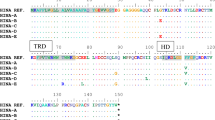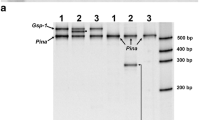Abstract
Barley seed proteins, Hordoindolines, are homologues of wheat Puroindolines, which are associated with grain hardness. Barley Hordoindoline genes are known to comprise Hina and Hinb, and Hinb consists of two Hinb genes, Hinb-1 and Hinb-2. Two types of allele were found for Hina, Hinb-1 and Hinb-2 genes, respectively, among Japanese two- and six-rowed barley lines. One of the alleles of Hinb-2 (Hinb-2b) had a frame-shift mutation resulting in an in-frame stop codon. For two-rowed barley lines, grain hardness was significantly higher among lines with the Hinb-2b than those with the wild type Hinb-2 gene (Hinb-2a). Protein spots corresponding to HINa, HINb-1, and HINb-2 were identified by 2D-gel electrophoresis among barley lines with Hinb-2a. Among the lines with Hinb-2b, HINa and HINb-1 were expressed at similar levels as those in the wild type, but HINb-2 was not detected. A DNA (cleaved amplified polymorphic sequence) marker was developed to distinguish between the Hinb-2a and Hinb-2b gene sequences. Analysis of grain hardness among F2 lines derived from a cross between a line with Hinb-2a (Shikoku hadaka 115) and a line with the Hinb-2b (Shikoku hadaka 84) showed significantly higher grain hardness in the mutant lines. From these results, the Hinb-2b frame-shift (null) mutation might play a critical role in barley grain hardness. The DNA marker will be useful in barley breeding to select lines having harder grain texture.






Similar content being viewed by others
References
Beecher B, Bettge A, Smidansky E, Giroux M (2002a) Expression of wild-type pinB sequence in transgenic wheat complements a hard phenotype. Theor Appl Genet 105:870–877
Beecher B, Bowman J, Martin JM, Bettge AD, Morris CF, Blake TK, Giroux MJ (2002b) Hordoindolines are associated with a major endosperm-texture QTL in barley (Hordeum vulgare). Genome 45:584–591
Bhave M, Morris CF (2008) Molecular genetics of puroindolines and related genes: allelic diversity in wheat and other grasses. Plant Mol Biol 66:205–219
Branlard G, Amiour N, Igrejas G, Gaborit T, Herbette S, Dardevet M, Marion D (2003) Diversity of puroindolines as revealed by two-dimensional electrophoresis. Proteomics 3:168–174
Caldwell KS, Russell J, Langridge P, Powell W (2006) Extreme population-dependent linkage disequilibrium detected in an inbreeding plant species, Hordeum vulgare. Genetics 172:557–567
Darlington HF, Rouster J, Hoffmann L, Halford NG, Shewry PR, Simpson DJ (2001) Identification and molecular characterisations of hordoindolines from barley grain. Plant Mol Biol 47:785–794
Fox GP, Osborne B, Bowman J, Kelly A, Cakir M, Poulsen D, Inkerman A, Henry R (2007) Measurement of genetic and environmental variation in barley (Hordeum vulgare) grain hardness. J Cereal Sci 46:82–92
Gamlath J, Aldred GP, Panozzo JF (2008) Barley (1→3; 1→4)-β-glucan and arabinoxylan content are related to kernel hardness and water uptake. J Cereal Sci 47:365–371
Gautier MF, Cosson P, Guirao A, Alary R, Joudrier P (2000) Puroindoline genes are highly conserved in diploid ancestor wheats and related species but absent in tetraploid Triticum species. Plant Sci 153:81–91
Giroux MJ, Morris CF (1998) Wheat grain hardness results from highly conserved mutations in the friabilin components puroindoline a and b. Proc Natl Acad Sci USA 95:6262–6266
Gorg A, Obermaier C, Boguth G, Csordas A, Diaz JJ, Madjar JJ (1997) Very alkaline immobilized pH gradients for two-dimensional electrophoresis of ribosomal and nuclear proteins. Electrophoresis 18:328–337
Henry RJ, Cowe IA (1990) Factors influencing the hardness (milling energy) and malting quality of barley. J Inst Brew 96:135–136
Ikeda TM, Ohnishi N, Nagamine T, Oda S, Hisatomi T, Yano H (2005) Identification of new puroindoline genotypes and their relationship to flour texture among wheat cultivars. J Cereal Sci 41:1–6
Iwami A, Kajiwara Y, Omori T (2003) Estimating barley character for shochu using a Single Kernel Characterization System (SKCS). J Inst Brew 109:129–134
Iwami A, Osborne BG, Huynh HN, Anderssen RS, Wesley IJ, Kajiwara Y, Takashita H, Omori T (2005) The measurement of structural characteristics of barley for shochu using Single-Kernel Characterization System 4100 crush-response profiles. J Inst Brew 111:181–189
Krishnamurthy K, Giroux M (2001) Expression of wheat puroindoline genes in transgenic rice confers grain softness. Nat Biotechnol 19:162–166
Law CN, Young CF, Brown JWS, Snape JW, Worland AJ (1978) The study of grain protein control in wheat using whole chromosome substitution lines. In: Seed protein improvement by nuclear techniques. International Atomic Energy Agency, Vienna, pp 483–502
Mattern PJ, Morris R, Schmidt JW, Johnson VA (1973) Location of genes for kernel properties in wheat variety ‘Cheyenne’ using chromosome substitution lines. In: Sears ER, Sears LMS (eds) Proceedings of 4th international wheat genetics symposium. University of Missouri, Columbia, pp 703–707
McCleary BV, Glennie-Holmes M (1985) Enzymatic quantification of (1→3, 1→4)-β-d-glucan in barley and malt. J Inst Brew 91:285–295
Neuhoff V, Arold N, Taube D, Ehrhardt W (1988) Improved staining of proteins in polyacrylamide gels including isoelectric focusing gels with clear background at nanogram sensitivity using Coomassie Brilliant Blue G-250 and R-250. Electrophoresis 9:255–262
Swanston JS, Taylor K (1988) The milling energy of malted barley and its relationship with hot water extract and α-amylase activity. J Inst Brew 94:143–146
Tranquilli G, Lijavetzky D, Muzzi G, Dubcovsky J (1999) Genetic and physical characterization of grain texture-related loci in diploid wheat. Mol Gen Genet 262:846–850
Turuspekov Y, Beecher B, Darlington Y, Bowman J, Blake TK, Giroux MJ (2008) Hardness locus sequence variation and endosperm texture in spring barley. Crop Sci 48:1007–1019
Acknowledgments
This work was partly supported by Research and Development Program of New Bio-industry Initiatives. We thank Mr. Takashi Nagamine for critical reading of the manuscript.
Author information
Authors and Affiliations
Corresponding author
Additional information
Communicated by P. Hayes.
Rights and permissions
About this article
Cite this article
Takahashi, A., Ikeda, T.M., Takayama, T. et al. A barley Hordoindoline mutation resulted in an increase in grain hardness. Theor Appl Genet 120, 519–526 (2010). https://doi.org/10.1007/s00122-009-1172-5
Received:
Accepted:
Published:
Issue Date:
DOI: https://doi.org/10.1007/s00122-009-1172-5




